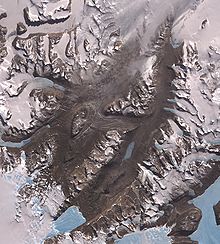User:Pcecola/sandbox
 | This is a user sandbox of Pcecola. You can use it for testing or practicing edits. This is not the sandbox where you should draft your assigned article for a dashboard.wikiedu.org course. To find the right sandbox for your assignment, visit your Dashboard course page and follow the Sandbox Draft link for your assigned article in the My Articles section. |
| Deinococcus frigens | |
|---|---|
| Scientific classification | |
| Kingdom: | |
| Phylum: | |
| Class: | |
| Order: | |
| Family: | |
| Genus: | |
| Species: | D. frigens
|
| Binomial name | |
| Deinococcus frigens Hirsch et al. 2006
| |
Deinococcus frigens is a species of low temperature and drought-tolerating, UV-resistant bacteria from Antarctica. It is Gram-positive, non-motile and coccoid-shaped. Its type strain is AA-692T (DSM 12807T).[1]
Taxonomy[edit]
Deinococcus frigens is an extremophilic, gram-positive cocci bacterium.[2] The Deinococcus genus is generally known for its resistance to very large doses of radiation, and the species D. frigens is no exception.[3] The species designation “frigens” refers to the harsh, cold climate of Antarctica where this microbe is found.[2] It is situated in a small clade of the Deinococcus genus that also includes two other species found in the area: Deinococcus saxicola and Deinococcus marmoris.[2] The closest relative to these more recently-discovered species is Deinococcus radiopugnans, which has a genome with a 96.1% similarity.[2] The full scientific classification of this species is Kingdom Bacteria, Phylum Deinococcus-Thermus, Class Deinococci, Order Deinococcales, Family Deinococcaceae, Genus Deinococcus, Species D. frigens.[2]
Discovery[edit]

Deinococcus frigens was discovered in 2004 by Peter Hirsch, a researcher at the Institute for General Microbiology of the Christian-Albrechts-University Kiel, in soil samples gathered from the ice-free McMurdo Dry Valleys of Continental Antarctica.[2] Though it is currently unknown if D. frigens can be found in other areas of the Antarctic, it may be possible for the microbe to exist in other areas of the same conditions. The soil sample containing D. frigens was collected from the top 0-4 cm of soil at pH 6.3.[2] To enrich for certain bacteria, the soil sample was added to PYGV medium and incubated at 9°C and pH 8.0.[2] PYGV is a media containing peptone, yeast, and glucose at low concentrations, first used to culture freshwater bacteria that could survive oligotrophic conditions, or low amounts of nutrients.[4] To isolate and cultivate these bacteria, enrichment samples taken at various time intervals were streaked on PYGV plates, where individual colonies could be subcultured onto PYGV slants.[2]
Morphology[edit]
Deinococcus frigens are Gram-positive, non-motile cocci whose colonies appear orange or pink.[2] Through comparison of the genomes of Deiococcus radiodurans and D. frigens, it has been predicted that no flagellar assembly exists in D. frigens.[5] Liquid-grown cells viewed using phase-contrast light microscopy and transmission electron microscopy on agar-coated slides show that isolated D. frigens appear to produce buds.[2] DNA sequences from six isolates found in the McMurdo Valley were determined by extraction of the genomic DNA, PCR amplification of the 16S rDNA, and analysis of the PCR product sequences. To determine their phylogenetic positions, these isolated sequences were subjected to comparative analysis. Using sequence databases, these six isolates were shown to all be related to the Deinococcus lineage; however, they form three coherent clusters, separate from other Deinococcus species. DNA-DNA similarity data, obtained using the DNA hybridization technique, shows that these three clusters represented three new species of Deinococcus, and were given the names D. frigens, D. saxicola, and D. marmoris.[2]
References[edit]
- ^ Hirsch, Peter; Gallikowski, Claudia A.; Siebert, Jörg; Peissl, Klaus; Kroppenstedt, Reiner; Schumann, Peter; Stackebrandt, Erko; Anderson, Robert (2004). "Deinococcus frigens sp. nov., Deinococcus saxicola sp. nov., and Deinococcus marmoris sp. nov., Low Temperature and Draught-tolerating, UV-resistant Bacteria from Continental Antarctica". Systematic and Applied Microbiology. 27 (6): 636–645. doi:10.1078/0723202042370008. ISSN 0723-2020.
- ^ a b c d e f g h i j k l Cite error: The named reference
:1was invoked but never defined (see the help page). - ^ Cite error: The named reference
:2was invoked but never defined (see the help page). - ^ Cite error: The named reference
:3was invoked but never defined (see the help page). - ^ Cite error: The named reference
:4was invoked but never defined (see the help page).
Further reading[edit]
- Bej, Asim K., Jackie Aislabie, and Ronald M. Atlas, eds. Polar microbiology: the ecology, biodiversity and bioremediation potential of microorganisms in extremely cold environments. CRC Press, 2009.
- Staley, James T., et al. "Bergey’s manual of systematic bacteriology, vol. 3."Williams and Wilkins, Baltimore, MD (1989): 2250-2251.
External links[edit]
- {{EOL}} template missing ID and not present in Wikidata.
- LPSN
- Type strain of Deinococcus frigens at BacDive - the Bacterial Diversity Metadatabase
